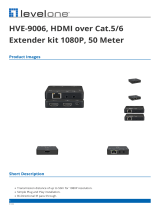
Page8
Notice: How to get the best HDMI display results
Many factors influence the quality and reliability of an HDMI® signal
distribution installation. The following are the main factors to consider, and
basic precautions that will ensure the best possible performance.
1. Dedicated network.
The HVE-650/660 Series is designed to operate on a dedicated Gigabit
Ethernet network, not to be combined with other network traffic or with
access to the internet.
2. Resolution tracking.
a. Set up the source to output the best resolution that all TVs are capable
of displaying.
b. The HVE-650/660 Series supports 720p and 1080p. If some TVs in the
network are not capable of accepting 1080p, the higher resolution sets
may not be shown to their best advantage.
3. Source resolution and video/sound quality.
Sources, such as satellite receivers or cable boxes, can output at low
resolutions or deliver extremely compressed video material, yielding poor
results. Consider the source when planning and troubleshooting your
system.
4. Display devices.
The perceived quality of the video image depends heavily upon the type
and quality of the TVs or projectors used. High quality displays should be
expected to produce a noticeably better image.
5. Distance between the transmitter and the receiver.
Long distances are possible, but premium quality Cat 5e/6 cables are
necessary for the longest runs.
6. Source and TV connection cables.
Use short, premium HDMI cables; low quality cables are often unreliable.
Always use good strain relief methods or locking cables to prevent cables
from becoming loose over time.
7. Interference from nearby electrical devices
It can have an adverse effect on signal quality. For example, older
computer monitors often emit very high electromagnetic fields that can
interfere with the performance of nearby video equipment.









